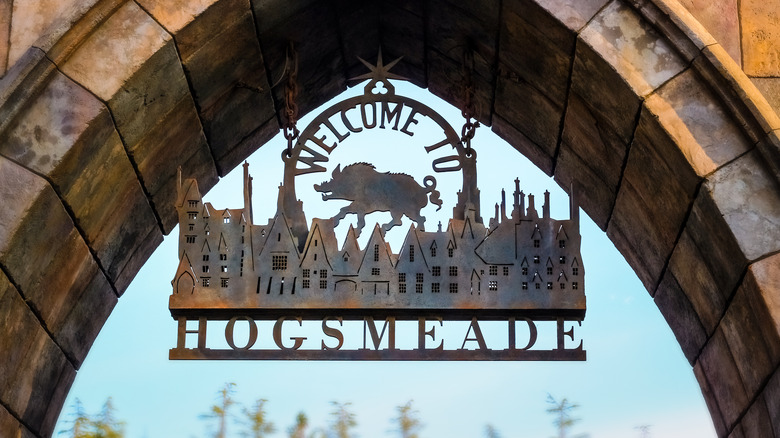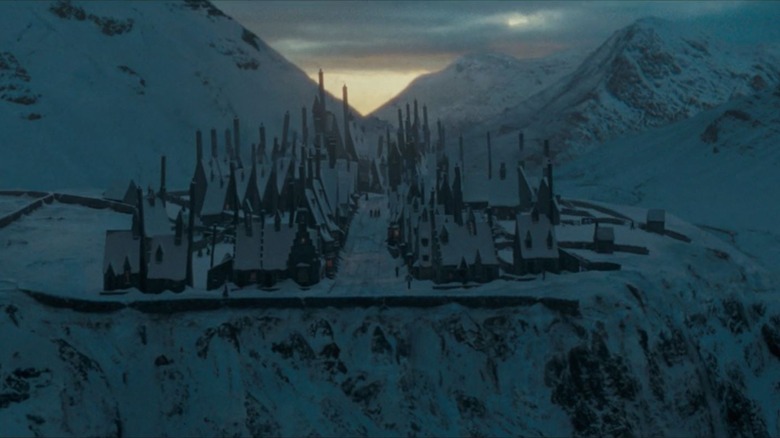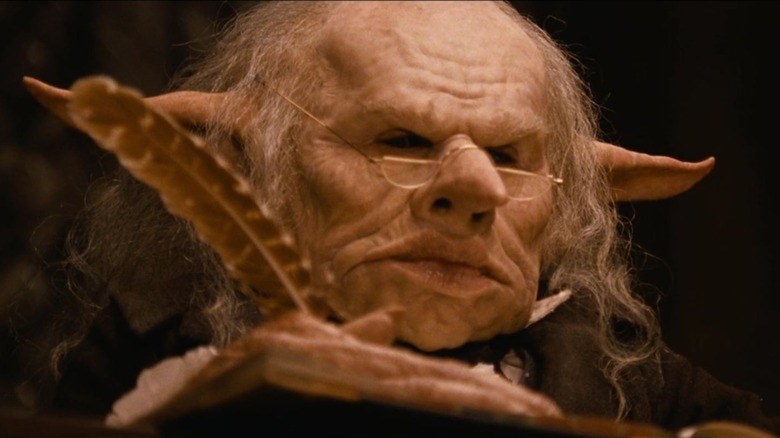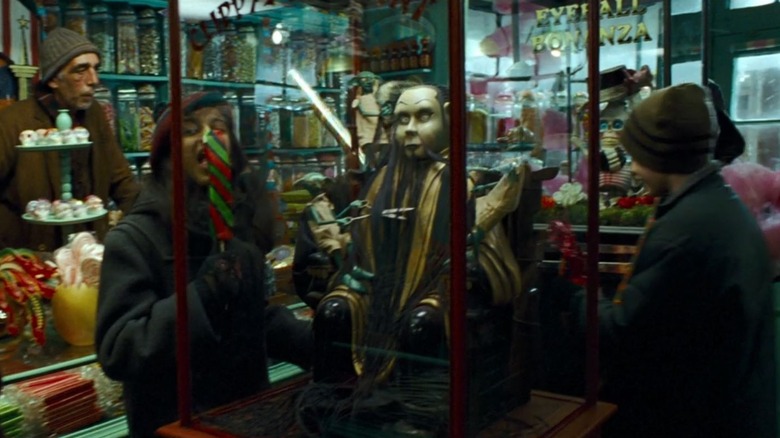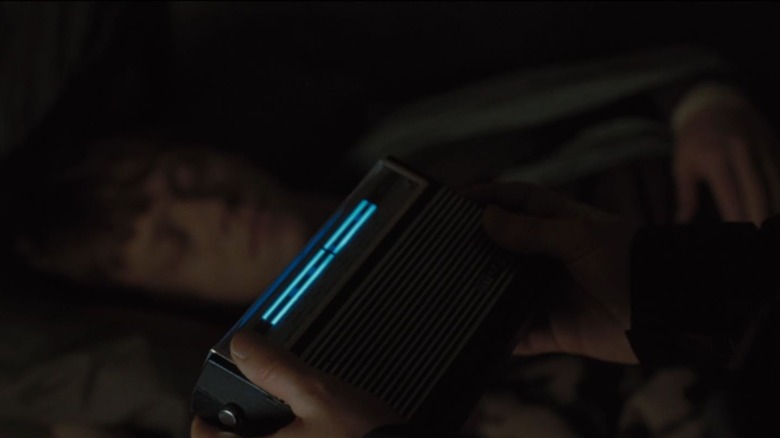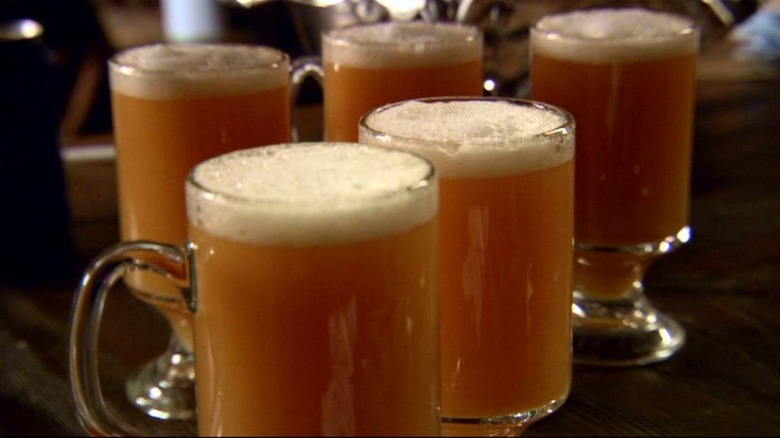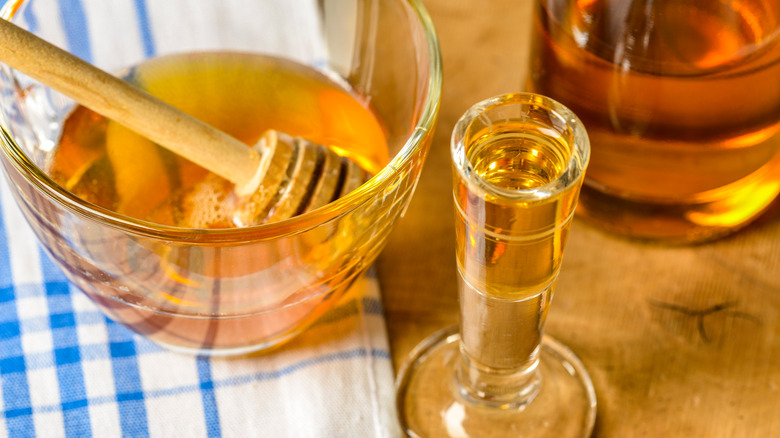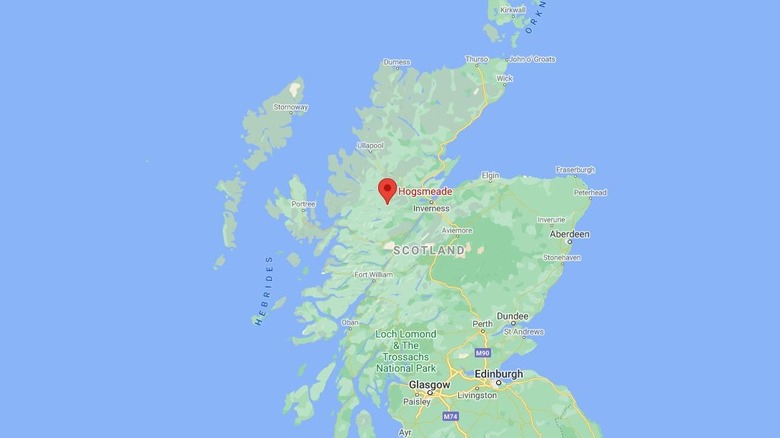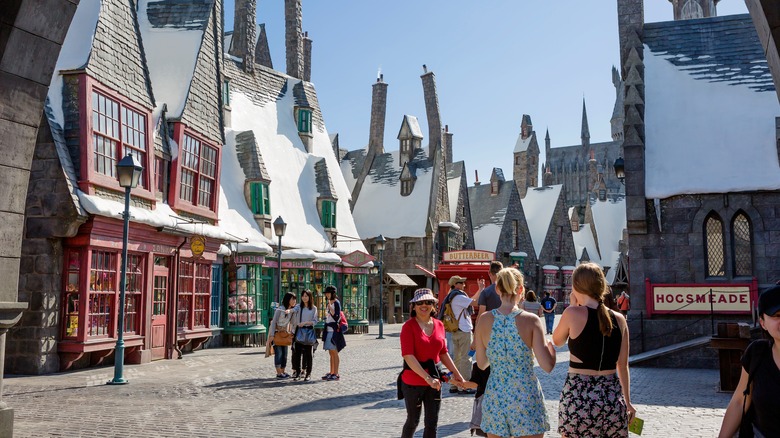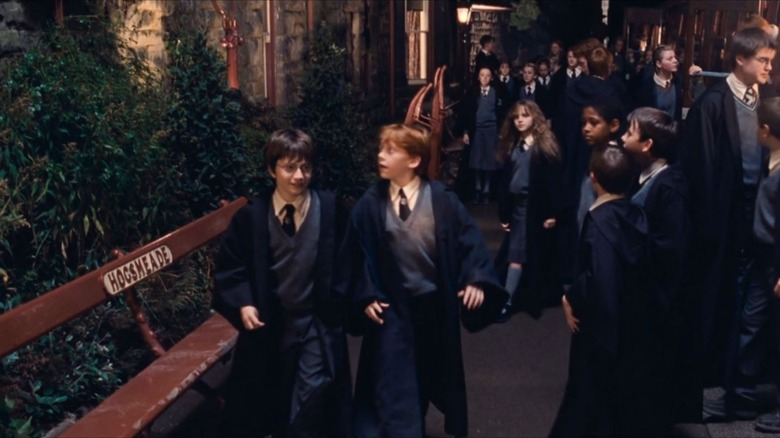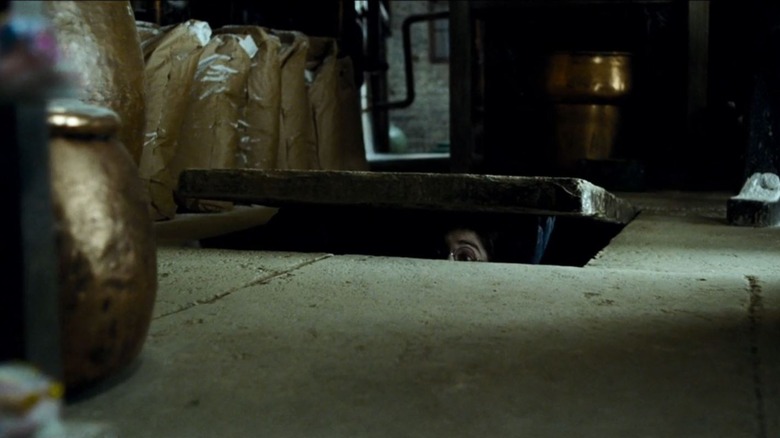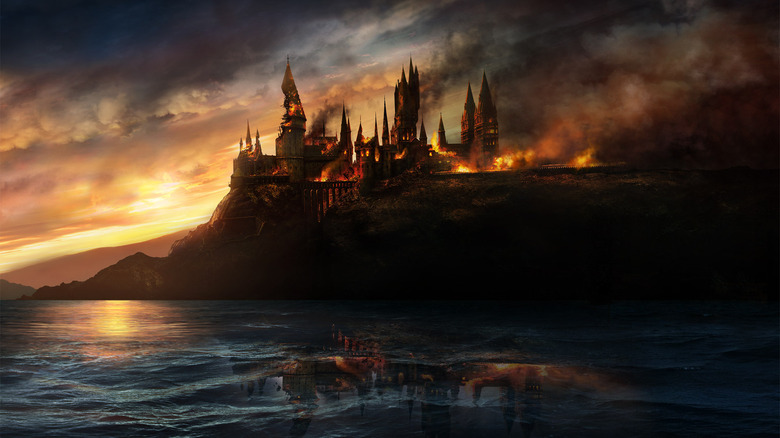Harry Potter: The Untold Truth Of Hogsmeade
It may not be anywhere near as famous as its neighbor, but the village of Hogsmeade has a charm and glamour all its own. Nestled somewhere in an unspecified mountain range in Scotland, this little hamlet is easily accessible from the "unplottable" campus of the internationally renowned Hogwarts School of Witchcraft and Wizardry. Hogsmeade is a beautiful collection of warm cabins with snow-covered rooftops silhouetted against the mountains that surround it on every side and of shops that keep its streets filled and busy with traffic.
Though not as mysterious as its erstwhile neighbor, Hogsmeade has its own collection of secrets. Originally founded just after Hogwarts sometime in the 10th or 11th century, the village has had around one thousand years to build up a substantial amount of bones in its closet, and they must be brought to light. It is time to learn the untold truth of Hogsmeade Village.
Hogsmeade is the only all-wizarding village in Great Britain
Originally introduced in "The Prisoner of Azkaban," Hogsmeade Village was founded in roughly 900 or 1000 CE so that a small group of wizards could know rest from the growing number of bigots and fools who feared them for their differences and believed them to be evil. They wished to escape muggle persecution, so the founders made sure that Hogsmeade became the first and, as far as fans know, only all-wizarding village in all the British Isles.
By doing this, the village escaped many of the witch-hunts that would come over the following millennia, and it would eventually allow them to let their citizens exist and practice magic without them ever taking the risk of threatening the International Statute of Wizarding Secrecy. Under this law, all witches and wizards are required to keep their magic hidden from the outside world, but since that very world was never allowed within Hogsmeade in the first place, its visitors don't need to worry about that.
It's founder may have been taught by Helga Hufflepuff herself
The village was founded during the middle ages by a man named "Hengist of Woodcroft." As a character, Hengist is unique in that, though he was originally mentioned in the "Harry Potter and the Sorcerer's Stone" novel, most of what fans know of him comes from "Famous Wizard Cards" included as collectibles throughout the franchise's many video games and sold at The Wizarding World of Harry Potter theme parks.
Born in the late 890s, Hengist would have been one of Hogwarts' earliest students as it wouldn't be established until the early 900s CE. The man was sorted into Hufflepuff, and if the dated beginning of both Hogwarts and his own existence is accurate, then the English wizard may very well have been one of Helga Hufflepuff's — the house's original founder — first pupils.
It's likely he founded the village at some point after he graduated from the school, but that's not known for sure. Another common legend is that The Three Broomsticks Inn, one of the village's central buildings and foundational institutions, was the first house that Hengist built and lived out of until he died sometime later on in the Medieval period. What is known for sure, however, is that the village's founder is one of the many collectible "Chocolate Frog Cards."
It was the wizarding headquarters during a goblin rebellion
Brilliant smiths of all kinds of weaponry and incredible accountants, the goblins in the wizarding world of "Harry Potter" are fairly unique within the fantasy genre. Relatively small, "The Sorcerer's Stone" explained that these goblins are an enchanted race who can all practice their own kind of magic without the aid of a wand, and as the people who ran the famed Gringotts Wizarding Bank, they had a pretty strong hold over the Wizarding World's economy.
Despite these many talents and positions of power, however, goblins were still typically treated as second-class citizens. Though they weren't literally enslaved like the house elves, they were generally viewed as lesser beings by many wizards and were forbidden from carrying or using a wand as the humans did by law.
Because of this, there have been many Goblin Rebellions over the centuries, and "Prisoner of Azkaban" revealed that one of these took place so close to Hogsmeade Village in 1612 that the ones in charge of running the countermeasure chose to use one of the village's inns as their headquarters and staging area, though it's not known which of its inns they may have used.
The village has more shops that you can shake a wand at
Between its status as an all-wizarding village and its proximity to Hogwarts, Hogsmeade might have the best, most impressive collection of wizarding shops outside of Diagon Ally. Between real-world recreations at theme parks and visits to the town in both "Prisoner of Azkaban" and "Order of the Phoenix," fans have seen a wide and varied assortment of shops available on the town's "High Street."
The Hog's Head and Three Broomstick Inns, for example, can provide any visitor with a place to sleep, food to eat, and all the butterbeer they can drink. Zonko's Joke Shop helped inspire the Weasley Twin's Weasleys' Wizard Wheezes in Diagon Alley, and the candy shop named Honeydukes helped Hogwarts' younger students satisfy their sweet tooth while the older kids went on awkward dates at Madam Puddifoot's Tea Shop.
The market also had anything a witch might need to replenish her wizarding supplies. Between Ceridwen's Cauldrons, Dominic Maestro's Music Shop, Gladrags Wizardwear, J. Pippin's Potions, Potage's Cauldron Shop, Scrivenshaft's Quill Shop, Spintwitches Sporting Needs, a branch of Olivander's Wands, and Tomes and Scrolls, a student was likely to find whatever they needed there. If none of those stores carried something, then customers could check out Dervish and Banges for repairs, Dogweed and Deathcap for exotic plants, the Magic Neep for groceries, and a hairdressing salon.
It even has its own radio station
One of the most unique institutions on Hogsmeade's bustling "High Street" was the studio headquarters of the Wizarding Wireless Network radio station. Given the station's proximity to Hogwarts, it's not surprising it was extraordinarily popular among young witches and wizards all over Great Britain.
The station hosted a variety of regular shows, played a host of the most popular musical hits, and regularly updated its audience on news from around the Wizarding World. Glenda Chittock's "Wizarding Hour" was the most common source of music on the air, and Tilden Toots' "Toots, Shoots 'n' Roots" herbology segment was a popular piece of media among the nation's avid mystical gardeners.
During Voldemort's brief reign during the Second Wizarding War, WNN and its news segments basically became unreliable propaganda tools of the now-corrupt Ministry of Magic, and a rival, pirate radio station called "Potterwatch" soon became its main competitor, as those who wished to know what was actually happening now had to tune in there.
Its famous "Butterbeer" may or may not contain alcohol
For all its features and draws, Hogsmeade is perhaps still best known for its widely acclaimed "butterbeer." Served in both cold bottles and in hot, foamy tankards, butterbeer tasted like butterscotch that wasn't quite so overwhelmingly sweet, and its entire ingredients list was basically just butterscotch, water, and sugar.
The drink is a staple tourist item both for students visiting Hogwarts within the series and for fans visiting the Wizarding World's theme parks and attractions, but it does pose one seemingly eternal question: does it actually contain alcohol? It was at least capable of getting the tiny house elves "drunk" in "Goblet of Fire," but it's unclear if that was due to its high alcohol content or because their body chemistry is so different from humans.
Similarly, since the majority of the school's students are under the UK's legal drinking age of 18 and yet they still gobble it all up, it would seem like butterbeer would need to be nonalcoholic to be sold to young children.
The town isn't named after its most popular drink
However, despite Butterbeer's intense popularity both among fans and within the Wizarding World, the village its famous for is named after a different kind of drink entirely: "mead." One of the oldest recorded forms of alcohol ever, mead is an alcoholic beverage that's derived from fermenting honey. It's commonly associated with Vikings and is often used in works of fiction that are set within medieval fantasy worlds.
Though mead is often referred to as "honey wine," that's not a very accurate description. All alcohol is created by fermenting sugar from different sources. Wine is fermented from grapes, beer from barley or wheat, and so on. Fermenting honey allows mead to be extraordinarily sweet, though many are made to be dry, light, and even sparkling. Mead can be served either hot or cold and is even commonly spiced so it can be served like a sort of hot, mulled cider.
Google Maps has a real-life location for the village that's nearly impossible to reach
In the Wizarding World of Harry Potter, the exact locations, and often even or especially the entrances to magical locations are rendered "unplottable" through the use of various spells. This makes it literally impossible to place the location on a map and, in some cases, even incapable of being found in person without some piece of hidden knowledge. Hogwarts is one of several unplottable locations, and given Hogsmeade's historic troubles with persecution from muggles, it seems reasonable to assume its location has been hidden in a similar manner.
Unfortunately for one of the largest corporations on earth, Google Maps didn't get the memo, and its official location for the famous Hogsmeade Village directs to the middle of nowhere, to a location that is so remote that only expert climbers can actually reach it safely. While it's nice that this will keep tourists from damaging or littering in the area, it does appear that the spells protecting the location are still working quite well.
There's a recreation of the village at The Wizarding World of Harry Potter
The Wizarding World of Harry Potter is more than just another way to refer to the popular franchise; it's also the name of one of the most successful theme parks in the United States of America. Located across two different parks in Florida, these theme parks allow fans to enter incredible replications of famous characters and locations from the series.
They can go on a tour of Hogwarts castle, ride the Hogwarts Express, shop in Diagon Alley, ride along in Hagrid's motorbike as he shows them magical creatures, and even visit the bustling town of Hogsmeade in person. The recreation can be found at the foot of their Hogwarts castle, and visitors can browse all of its many shops and drink all of the butterbeer they can stomach. Many of the shops that can be found here were never seen in the films or mentioned in the books, so it functions quite well as an expansion on what fans already knew about the town.
Hogwarts students have been visiting the village for over 300 years
Though the village was founded by a Hogwarts student around the year 900, students weren't formally allowed to visit Hogsmeade on school-sanctioned "field trips" like they do in "Prisoner of Azkaban" until the 1714 Edict was passed several hundred years later, finally permitting students to visit on weekends starting in their third year at the institution. Since then, students have been a common and regular site in the village, and its many shops benefit greatly from their frequent patronage.
Though many students visit Diagon Alley for their educational supplies before beginning the school year, it's not practical to return during the term if something comes up. Instead, it's much easier to shop in Hogsmeade, which has a shop for every magical material that a student might need during the year.
Similarly, students love to take advantage of Hogsmeade trips to stock up on sweets, butterbeer, party supplies, and various materials for pranks. "Order of the Phoenix" establishes that it's also one of the most popular destinations for dates, as it's one of the only places that couples can go that isn't on school grounds.
Hogsmeade station is the Hogwarts Express' final destination
Most fans of the films will remember seeing Hogsmeade for the first time in "The Prisoner of Azkaban" without realizing that they actually first laid eyes on it two films before in "The Sorcerer's Stone." When the Hogwarts Express drops off its students at the end of their long journey, it does so at Hogsmeade Station.
Located at the edge of the village, this is the train's only stop, making it one of the village's most important landmarks and showing just how important Hogsmeade and Hogwarts are to each other, even though it often seems as if the two share little more than part of a name. Though it's not clear where exactly the station is, it's quite special to realize that many first-year students' first glimpse into the magical reality of their new school is none other than the gentle little hamlet of Hogsmeade.
Hogsmeade contains eight secret routes to Hogwarts
The ties between Hogsmeade and Hogwarts run deep. So deep, in fact, that "Prisoner of Azkaban" established that there are no less than eight secret passageways that connect the two Hogs together. Four of the eight paths were seldom used at all, as Filch, the Hogwarts groundskeeper, knew all about them and guarded them zealously.
One passageway started at a brick wall behind Hogwarts Castle and traveled through to the east side of the village. Another began on the school's third floor at a statue; once the statue was tapped and given the password, it would slide open to reveal a path that lead to a trap door inside the cellar of the Honeydukes candy shop. There were also two disabled paths that had been destroyed through one means or another. One tunnel with an entrance behind a mirror had caved in, and the route through the Room of Requirement that may have been damaged by the battle in its walls in "The Deathly Hallows."
The most interesting route, however, is the secret tunnel built by Dumbledore for Remus Lupin that ran from underneath the Whomping Willow all the way to Hogsmeade's "Shrieking Shack." The passage was built to give Lupin a place to go every full moon when he transformed into a werewolf. Lupin was safe there, and the shack's legendary status as the most haunted house in the U.K. would keep everybody else away and safe from him.
During the Battle of Hogwarts, Hogsmeade came to the school's defense
The bond between Hogwarts and Hogsmeade was tested and proved during the Battle of Hogwarts in "The Deathly Hallows." Under siege by the dark lord Voldemort and his army of evil creatures and Death Eaters, the faculty and students rallied to defend their beloved school from the end of the world as they knew it. Supplemented with what Aurors and allies they had, the battle likely would have been lost if not for their favorite little village.
Hogsmeade provided two crucial boons to the beleaguered heroes of Hogwarts. First, they were a place of safety where the underage students and other non-combatants could be evacuated and kept away from the battle. Second, they were a source of much-needed reinforcements as the war dragged on.
Using the secret pathways between the two hogs, Horace Slughorn took the first wave of students across, rallied the witches and wizards of Hogsmeade to his side, and then stormed back across to rejoin the battle with his newly acquired soldiers. Additionally, any other reinforcements from members of the Order of the Phoenix were easily able to bypass the Death Eaters' siege lines by arriving in Hogsmeade and reaching the castle through the same paths.
